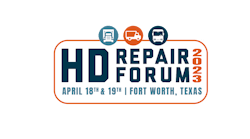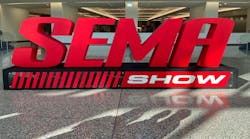When it comes to fleet finishes, protecting company assets and representing the brand are equally important for any fleet manager. Many companies have brands that are immediately recognizable because of their fleet of vehicles. These rolling billboards are seen by thousands of people each and every day.
Consistent branding is key to consumer awareness and oftentimes, buying decisions. That’s why it’s imperative to have a quality finish that can deliver durability and an outstanding appearance on a fleet vehicle.
Given this fact, it’s surprising that the finish on a fleet vehicle or piece of equipment is often only prioritized on an as-needed basis. And yet, because the finish plays an essential part of protecting the different vehicle surfaces, it is recommended that fleet managers inspect their fleet’s finish as part of their regular maintenance routine.
Recent studies conducted by Sherwin-Williams Automotive Finishes among fleet managers and painters show that their number-one coatings concern is durability of the finish.
Part of the job of a fleet manager is to protect the fleet of vehicles, and durability can mean different things to different managers. A northeastern U.S. fleet manager is more worried with corrosion due to magnesium chloride or road salt, while his (or her) counterpart in the southeast is probably more concerned about UV resistance.
A close second to durability concerns is the final appearance of the paint system. Fleet managers want - and expect - excellent gloss, appearance and consistent colors.
Finishing Needs
When it comes to fleet finishing, typically a fleet manager’s needs fall into a couple of categories. The first is speed/productivity - decreasing or minimizing downtime for a vehicle is imperative. The second is controlling or minimizing cost.
There are hundreds, if not thousands, of decisions to be made by fleet managers, and when it comes to a coatings supplier selection, it can be a daunting task. But there are people and services available for these managers.
For instance, Sherwin-Williams and other manufacturers conduct shop assessments to help managers make decisions on product needs as well as offer services like Six Sigma, and Lean and Design Engineering to optimize shop practices, and workflows to minimize vehicle downtime.
In our case, we do this on a nationwide scale through our company-owned branches, which is important for fleet organizations with multiple shops looking for consistent service levels.
This is necessary because many national fleets will have their own shops where maintenance, including paint refinishing, is done. Regional or smaller fleets may elect to have work done through independent shops.
There is nothing wrong with either model. It’s just a matter of determining your fleet’s needs and services capabilities, and then doing what is most efficient and cost effective for the company.
Product Overlap
Automotive and fleet coatings are often synonymous. There is quite a bit of overlap in products for automotive and fleet/truck applications. However, depending on the needs of a shop, certain things can be different than an automotive application.
By way of example, manufacturers offer a variety of products where a painter can customize the dry time and cure speed for the given product. From primers to topcoats and clearcoats, we all want to ensure that a shop is being as efficient as possible.
A dry time that works on a car application isn’t necessarily a good fit for a larger truck application. That’s why it is important to choose a versatile paint supplier.
There are also times when a customer will come to us with a particular need or specification. We work very hard to develop and deliver new products that are focused on meeting the specific requests and needs.
Paint Products
Regarding the actual paint products, the push for lower VOC (Volatile Organic Compound) coatings continues to be the biggest initiative in recent years. Painters and fleet managers are demanding products with better coverage and faster process times.
In the coming years, we see coatings continuing to move toward lower VOC, waterborne technology and products that offer faster process times.
An example of a product with faster process times would be Sherwin-Williams’ recently launched Genesis HP Premium Single Stage coating.
This is a finish that offers unmatched drying capabilities, cure times and faster processing - all without baking, so the savings in time and money to a shop will be significant. This means faster process times, with less natural resource consumption, all resulting in further savings as well as a reduced carbon footprint.
Supplier Selection
Fleet managers in these tough economic times are always being asked to do more with less. But when it comes to their fleet’s finishes, they seem to know its best not to be "penny-wise and pound-foolish."
In the market study referenced previously, only 7 percent of all fleet managers interviewed said that price was their most important attribute when it came to choosing a paint brand supplier. This is because fleet managers know the importance of balancing cost and quality when selecting their paint finishing and refinishing systems.
After all, the right finish provides right protection for their vehicles, as well as their brand.


